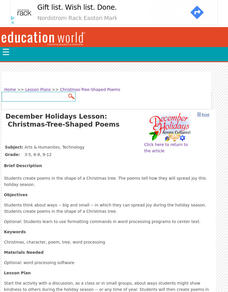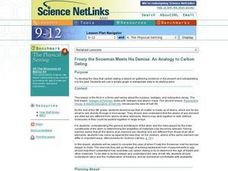Tune Into English
Yellow Submarine – The Beatles – Notes
Enhance English language skills using the fan-favorite song, "Yellow Submarine" by The Beatles. Scholars predict what the song is about then listen and mark specific words they hear. Playing the song again, participants unscramble lyrics...
Crafting Freedom
Sequencing of Events in the Slave Narrative of Henry "Box" Brown
What steps did Henry "Box" Brown take while planning his own escape from slavery? Learners work in groups to analyze segments of Brown's narrative and identify the sequence of the most important events of his story.
Civil War Trust
Genealogy
The Civil War is undoubtedly a part of America's history, but could it be part of your pupils' history as well? Middle schoolers conduct research to discover a connection between their ancestors and the American Civil War. Whether they...
Mr. Nussbaum
Fort Sumter Reading Comprehension
The Battle of Fort Sumter was both the first and the least deadly battle of the American Civil War, with no soldiers lost during the lengthy bombardment. Learn more about the first shots of the Civil War with a short reading passage and...
Macmillan Education
White Fang
Jack London's adventurous novel White Fang may seem removed from students' everyday lives, but with an engaging set of reading activities, learners can relate to the story's themes. A three-page assignment delves into the novel before,...
New Bedford Whaling Museum
A New Bedford Voyage!
A thorough set of activities, articles, and reference material can enlighten your class about the history of whaling in New England. Kids travel back to a time when whale products were valuable and hunting whales was a way to help the...
Beyond Benign
Daphnia Bioassay LD50
De-icing materials may have a harmful effect on our environment; have your class perform an experiment to test the nature of these effects. Scholars monitor the survival rate of a sample of daphnia as the concentration of a de-icing...
PBS
Star Power
Let there be light—or maybe not. Pupils learn about light pollution with an investigation of constellations. They create constellation boxes and experiment with different levels of light. Observations are then made about the lighting in...
Curated OER
A Stinking Smelly Sewer
Students create a timeline of events that occurred in the Nashua River Valley as presented in the book, "A River Ran Wild." They write a description of a selected time period on an index card for a class timeline, and write a letter to...
Curated OER
Dear Abby or Dear Ann
Students practice their writing skills by composing an opinion letter in response to a topic identified by a writer to Dear Abby or Dear Ann Landers. Effective communication skills form the basis of this lesson.
Curated OER
The Elf Project
Third graders research elves and create their own elf description which they use to write back to the first graders Santa letters.
Curated OER
All About Me
High schoolers examine their own personality traits and preferences. They use this information to write an autobiography.
Curated OER
Hidden Summer Vocabulary Builder
In this hidden summer vocabulary builder worksheet, students fill in the missing letters in 70 words using definitions and descriptions, then write 8 short answers about summer.
Curated OER
Ugly? Says Who?
Students explore biology by writing animal poetry in class. In this animal characteristics lesson, students research the Internet for facts about an "ugly" animal such as a bug or small critter. Students complete worksheets about animal...
Curated OER
Animal and People Habitats
Students examine how animals create a unique space in which they can live. Students read a poem about animals' habitats discuss the habitats. They draw a space of their own and write a poem that describes their habitat.
Curated OER
Metric Cookies
Sixth graders convert English to Metric units. In this converting English to Metric units lesson, 6th graders convert a cookie recipe in English units to Metric units. Students write a letter to a pen pal in England where they convert...
Curated OER
Beginning and Ending Sounds for Grade 2
In this beginning and ending sounds for grade 2 worksheet, 2nd graders look at the picture and fill in the beginning and ending letters, not interactively, for 6 pictures; pictures can be changed and answers are available online.
Curated OER
Christmas-Tree-Shaped Poems
Students create poems in the shape of a Christmas tree. They write an original poem detailing how a person can spread joy during the holiday season. The poem is formatted in the shape of a Christmas tree.
Curated OER
Alphabetizing Words Beginning with R and S
Learners alphabetize words that begin with R and S. In this alphabetizing lesson, students complete a worksheet in which they alphabetize words that end with R and S. After a classroom discussion about how to alphabetize, learners...
Curated OER
Frosty the Snowman Meets His Demise: An Analogy to Carbon Dating
Students read and discuss an article about carbon dating, then participate in a hands-on lab to discover how carbon dating works. Students also write a letter to a friend explaining the process, and how archeologists use the process to...
Curated OER
Describe My City
Students explore the functions of cities by creating a visual image of their own neighborhood. Students diagram, list, and label the major businesses and cultural areas of the neighborhood where they grew up, then write a letter to a...
Curated OER
Getting Here from There
Students role-play early 20th century immigrants on their way to Indiana. They consider the methods of travel available to them and write a letter to a friend outlining their travel plans and adventures during the trip.
Curated OER
I Am Unique! - Using the Pronoun I
In this language arts learning exercise, students read that the word I is always written as a capital letter. They read 9 sentences and write each one using the capital I when necessary.
Curated OER
Tikki Tikki Tembo Activity Card
In this reading worksheet, students respond to the book Tikki Tikki Tembo, by Arlene Mosel, by completing an activity at home with a parent. Students think of names of friends, family members, and classmates. Students write their names...

























